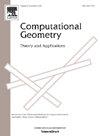城市守卫用有限视野的摄像机
IF 0.7
4区 计算机科学
Q4 MATHEMATICS
Computational Geometry-Theory and Applications
Pub Date : 2025-09-25
DOI:10.1016/j.comgeo.2025.102230
引用次数: 0
摘要
本文主要研究与城市防卫和美术馆相关的两个问题。给定一个有k个矩形建筑的城市,我们证明3k+1个180°视场摄像机总是足以保护自由空间(地面、墙壁、屋顶和天空)。这回答了Daescu和Malik(2020)[7].2的猜想。给定平面上共有m个顶点的k个正交凸多边形,我们证明m2+k+1个180°视场摄像机总是足以保护自由空间(避免所有的多边形)。这回答了Daescu和Malik (2021) b[8]的另一个猜想。这两个上限都很紧,因为输入实例需要这么多摄像机。我们的证明是建设性的,并提出了简单的多项式时间算法来放置这些许多相机。然后,我们将上述界限推广到任意凸形建筑物。我们可以保护k个总尺寸为m × m−k+1个摄像机的建筑物的自由空间。对于平面上有c个凸顶点的k个简单多边形,我们可以通过c−k+1个摄像机来保护自由空间。这两个边界都很紧。本文章由计算机程序翻译,如有差异,请以英文原文为准。
City guarding with cameras of bounded field of view
We study two problems related to the city guarding and the art gallery problems.
- 1.Given a city with k rectangular buildings, we prove that cameras of field of view are always sufficient to guard the free space (the ground, walls, roofs, and the sky). This answers a conjecture of Daescu and Malik (2020) [7].
- 2.Given k orthogonally convex polygons of total m vertices in the plane, we prove that cameras of field of view are always sufficient to guard the free space (avoiding all the polygons). This answers another conjecture of Daescu and Malik (2021) [8].
We then generalize the above bounds to arbitrary convex-shape buildings. We can guard the free space of k buildings of total size m by cameras. For k simple polygons with c convex vertices in the plane we can guard the free space by cameras. Again, both these bounds are tight.
求助全文
通过发布文献求助,成功后即可免费获取论文全文。
去求助
来源期刊
CiteScore
1.60
自引率
16.70%
发文量
43
审稿时长
>12 weeks
期刊介绍:
Computational Geometry is a forum for research in theoretical and applied aspects of computational geometry. The journal publishes fundamental research in all areas of the subject, as well as disseminating information on the applications, techniques, and use of computational geometry. Computational Geometry publishes articles on the design and analysis of geometric algorithms. All aspects of computational geometry are covered, including the numerical, graph theoretical and combinatorial aspects. Also welcomed are computational geometry solutions to fundamental problems arising in computer graphics, pattern recognition, robotics, image processing, CAD-CAM, VLSI design and geographical information systems.
Computational Geometry features a special section containing open problems and concise reports on implementations of computational geometry tools.

 求助内容:
求助内容: 应助结果提醒方式:
应助结果提醒方式:


